- The slow loris includes all the species of the genus Nycticebus, which range from Northeast India to Southeast Asia, Indonesia and the Philippines. Much still isn’t known about the genus, including the numbers of animals remaining in the wild. Not even the number of species is certain (the IUCN is raising the count from 8 to 9 this fall).
- These nocturnal primates are highly threatened by trafficking. Lorises are hunted for sale as pets, for traditional medicine, and for photo prop opportunities with tourists. Habitat loss is another leading cause of decline, though lorises have proven to be adaptable. They like forest edges, so can live near human communities successfully if left alone.
- The loris is unusual in that it is a venomous mammal, and its bite is toxic, and can be dangerous to humans. For that reason, traffickers pull the animal’s teeth when captured without use of anesthetics or antibiotics. Many captured for the pet trade die in transit.
- Dr. Anna Nekaris and the Little Fireface Project in Java, Indonesia, are leaders in the underfunded slow loris research and conservation effort. Rescue centers have arisen across Asia to protect the animals. Education is a key tool: Nekaris, for example, suggests not “liking” viral loris youtube videos, but instead offering conservation-related comments.

If you’ve ever heard of the slow loris, it’s likely for all the wrong reasons. People may coo over viral videos of pet lorises being tickled or eating rice balls, but the backstory behind those social media images is far from cute.
Slow lorises taken from the wild for the pet trade have their teeth pulled out to prevent them from biting — a job done with random tools and no protection from pain or infection. Pet lorises are usually kept awake during the day, which stresses these little nocturnal primates and damages their big “cute” eyes. And much of the behavior that looks adorable is evidence of distress — when a loris reaches for a tiny umbrella, it’s because this arboreal creature is desperate for a tree branch to hold onto. (That single youtube video has been viewed more than 6.8 million times.)
Overall, the loris is a poor pet — if the animals don’t perish being trafficked, they die in captivity from poor nutrition, improper handling or infection.
While the number of slow lorises in the wild is unknown, all species are subject to a combination of threats. In addition to the pet trade, they’re heavily hunted for use in traditional medicine. They’re also losing habitat in parts of Asia, as forests are destroyed for farms, roads and human settlements. For one species, the Javan slow loris, less than 20 percent of suitable habitat remains, and that is highly fragmented.
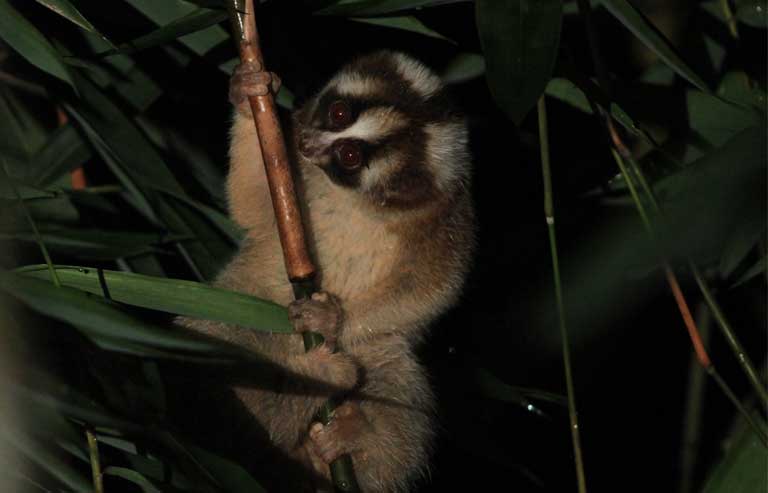
Fortunately for the slow loris, it has a passionate defender: Anna Nekaris and her associates at the Little Fireface Project in Java, Indonesia. The organization’s English name is a translation of the Sundanese word for loris: “muka geni”, which refers to the animal’s face mask, thought to look like flame-like tears surrounding the eyes.
Using tools ranging from basic scientific research to social media, The Little Fireface Project team is inspiring people to conserve the loris — starting in the village where the group is based, and rippling out to the rest of the world.
What is a slow loris?
The slow loris covers all the species of the genus Nycticebus, which range from Northeast India to Southeast Asia, Indonesia and the Philippines. It possesses a number of characteristics likely to fascinate humans, but there is a nearly unique trait that many people find to be the coolest: the loris possesses a venomous bite, and it is just one of a very few venomous mammals.
The main antagonists with whom lorises use this defense are other lorises (the males are very territorial), but the bite can also be dangerous to people.
The toxin is related to the allergen that causes people’s adverse reactions to domestic cats, and Nekaris knows of people who have nearly died of anaphylactic shock from a loris bite. She, in fact, co-wrote a paper with one of the afflicted.
Even the venom itself is unusual. The slow loris has a gland on its arm that it licks to start the defense process, but the gland secretions alone aren’t dangerous. It’s only when the glandular oil is activated by saliva that the combination becomes toxic. Nekaris notes that “The venom system is [even] more sophisticated than we previously thought,” and she is soon to publish a paper shedding more light on the process.
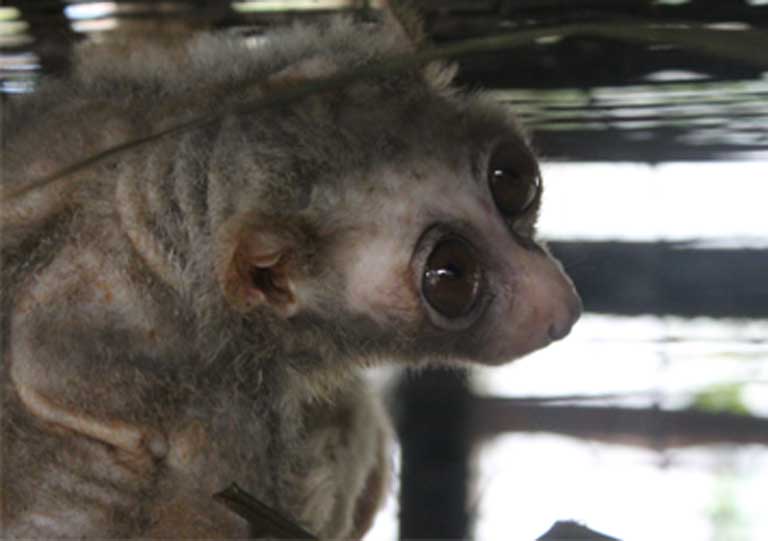
The mystery surrounding the loris’s toxic bite is just one of the animal’s enigmas. There are still some very basic unanswered questions, like how many species there are. When the status of the slow loris is updated later this year, the IUCN Red List will recognize nine species, all Endangered or Critically Endangered — an increase from the former eight species listed.
But Nekaris, who worked on the team that produced the update, thinks this number can’t possibly be the final word. She notes, for example, that what’s currently called the Bengal slow loris occurs over a huge range all the way from India to China. Compare this to other primates, she says: for gibbons and langurs, that vast area encompasses a couple dozen species of each. What’s more, the presumed Bengal slow loris possesses a remarkable range of attributes: “We have one loris [species]… that ranges from 2.4 kilos [5.3 pounds] to 600 grams [1.3 pounds]; that ranges from bright white to bright red. And it’s supposed to be] one species!” Obviously, she concludes, there is work to be done regarding these little studied creatures.
Species and subspecies designations and ranges may seem like arcane scientific hairsplitting, and of only academic interest, but those distinctions are crucial to conservation strategies. Think for instance of how invasive gray squirrels (Sciurus carolinensis) are driving red squirrels (Sciurus vulgaris) out of their UK habitat — lump the two species together as one and the endangered species problem suddenly vanishes.
A similar problem could easily occur if well-meaning researchers released closely related lorises in the wrong place — mistakenly mixing separate species or subspecies. Nekaris claims that such mistakes are happening now, even in cases where loris species divisions are already known, so it’s all the more important to work out the details of which species is which, and who belongs where.
When humans and lorises collide
The slow loris prefers a habitat marked by forest edges. That’s where sunlight creates the tight networks of intertwining branches and vines that the animals need to climb methodically with a pincer-like grip, moving from branch to branch.
Unlike many of their primate relatives, they can’t leap from tree to tree. Which is likely one reason they’ve been dubbed as “slow”; the other being their low basal metabolic rate, comparable to sloths and roughly 40 percent of other placental mammals.
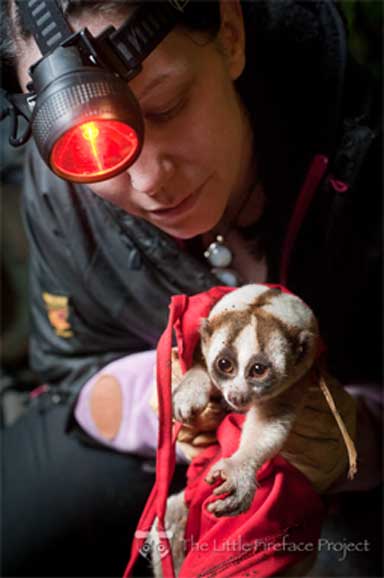
The lorises love for edges means that humans often inadvertently create good slow loris habitat by felling trees and by planting them — creating wood lots, tree plantations, croplands and other edge habitat.
Slow lorises thrive in the Little Fireface Project’s research site in the village of Cipaganti, West Java, for example, because the local farmers grow a tree known as the Green wattle (Acacia decurrens). Locally called Jiengjen, it provides a tree gum the lorises love to eat. Besides tree gum, the animals also consume fruit, nectar, insects, eggs and small animal prey.
But the loris’ attraction to human-created edges is a double-edged sword. While they may be drawn to a habitat and foods they love, forest edges across Asia are typically unprotected which puts the animals occupying them in the proximity of people and at risk.
“They can survive here, but at the total mercy of humans,” Nekaris says. “If the humans cut down all those trees, the lorises would be gone tomorrow.” And cutting trees to make more land to feed a booming human population is something farmers are doing throughout the range of the loris.
If the animals are to be conserved, then farmers need to be convinced of their worth, and that’s where Anna Nekaris’ team is focusing much of their basic research. One team member is observing the lorises to document their appetite for insects and value as pest controllers. An important recent discovery shows that the animals are very good pollinators. The loris has one of the longest tongues of any primate, so can get at nectar without destroying a plant’s flower. While pursuing its licks, the loris gets pollen all over its face, which comes along when the animal moves on to the next flower.
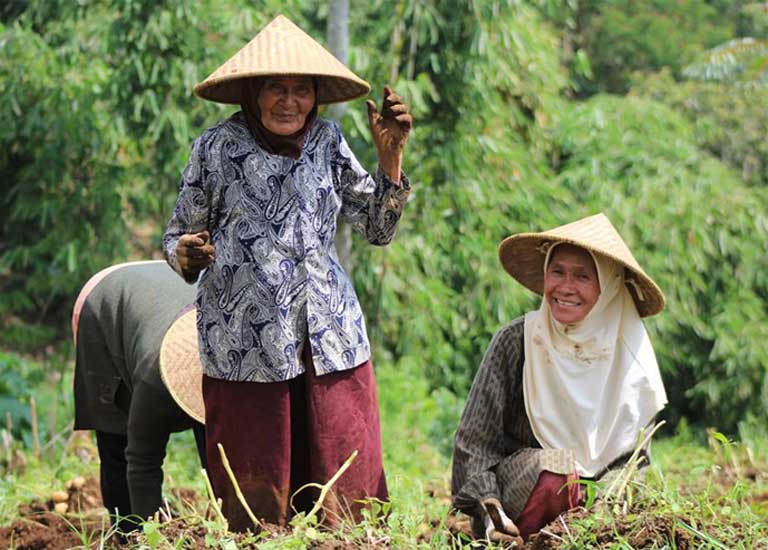
Team member Kathleen Reinhardt is currently working out the details regarding the ecological effects of loris pollination, an issue with deep scientific implications. “It’s already a theory that earlier primates co-evolved with angiosperms,” she says. “We can see if their behavior matches the theory.” This is also important information to share with local farmers, since they’re the ones who plant the trees she’s researching. If the loris helps propagate the trees and other plants farmers value, that it an important finding that could help support conservation.
The Little Fireface Project is also striving to bring the younger generation on board. “Kids are their own little patrol agents,” Nekaris says. “Kids like animals, and when someone catches one they want to see it.” So the team has developed an educational book that teaches children why it’s bad to hunt slow lorises, and emphasizes the importance of preserving them.
Sharing this knowledge is making a difference: “What we’ve found is that once people know these animals are in their area, and [grow] fond of them, they self-patrol and they don’t want people hunting their slow lorises,” Nekaris told Mongabay. “We find that in areas where we do this kind of education and empowerment, people don’t hunt [lorises] anymore, and five miles away where we haven’t done it, they are still hunting.”
Research and rescue
The loris lifestyle (its a slow-moving animal and easy to catch) along with its appearance and behaviors (which pet owners find adorable) makes this genus intensely popular with wildlife traffickers who snatch them up for the pet trade.
According to Dr. Chris Shepherd, Regional Director for TRAFFIC in Southeast Asia, slow lorises are protected from local hunting, capture, possession and trade in most range countries, and all slow loris species are listed in Appendix I of CITES, so international trade for commercial purposes is illegal.
But laws are of little use if not enforced, and that’s the problem. “In Indonesia, lorises are often traded openly in bird markets, such as the notorious Jati Negara Market,” Shepherd says. “The fact that the dealers in this market openly display these and other totally protected wildlife indicates their disregard for the law. It is also an indication of the poor enforcement effort.”

The problem is similar in Vietnam, according to Tilo Nadler of the Endangered Primate Rescue Center (EPRC) in Cuc Phuong National Park. “Even if the rangers confiscate a loris, prosecution is extremely rare,” he says. Between 2008 and 2013, during which EPRC took in 150 pygmy lorises and 40 slow lorises, 81 percent of the wildlife crime cases involving lorises resulted in no punishment.
Besides EPRC, there are other good centers that rescue slow lorises and reintroduce them to the wild, including the Endangered Asian Species Trust (EAST), also in Vietnam. Shepherd of TRAFFIC says that Indonesia has a good network of rescue centers too, that work hand-in-hand with the government.
The centers receive animals in a variety of ways, including confiscations by authorities, and surrenders by individuals who didn’t realize their pet was illegal. Rescuers argue that trafficking is the biggest threat to lorises: “They quite like the mixed habitat [found in the proximity of human communities], as long as left alone,” says Dr. Marina Kenyon, Director of the Dao Tien Endangered Primate Species Centre. But due to hunting for use as pets, medicine and tourist attractions, they’re not being left alone. “In the last eighteen months with increased awareness and Government focus on loris confiscations, the floodgates have opened and we have received over 40 pygmy lorises, compared to 4-6 in this period normally,” she says.
The basic loris research done by the Little Fireface Project is benefiting these far-flung rescue projects, helping keep confiscated lorises alive and healthy for their return to the wild. One important discovery made by the team concerns the animals’ consumption of tree gum: they eat a huge amount of it.
So any rescue center wanting to host confiscated lorises and do its job well, must either have the right trees readily available, and/or have a steady supply of tree gum. The project is actively sharing such findings with as many zoos and rescue centers as possible, since captive lorises often suffer from health problems caused by eating the wrong diet.
But restoring the animals’ health is only the first step in a successful rescue. Reintroduction involves a lot more than throwing a cage door open. Knowing the details of loris behavior and habitat preference matters.
In the past, when Nekaris and her team monitored reintroduced lorises, they found that 90 percent didn’t make it: the animals basically ran into the forest until exhausted and died of starvation.
“One of the things this suggested to me was that the habitat [into which they were released] wasn’t right, and they were running looking for the right habitat,” Nekaris says. “Ours is the first long term study of slow lorises ever in the wild, and every two months [or so] we’re discovering something so amazing and so new, that [it] fundamentally changes how you do a reintroduction.”
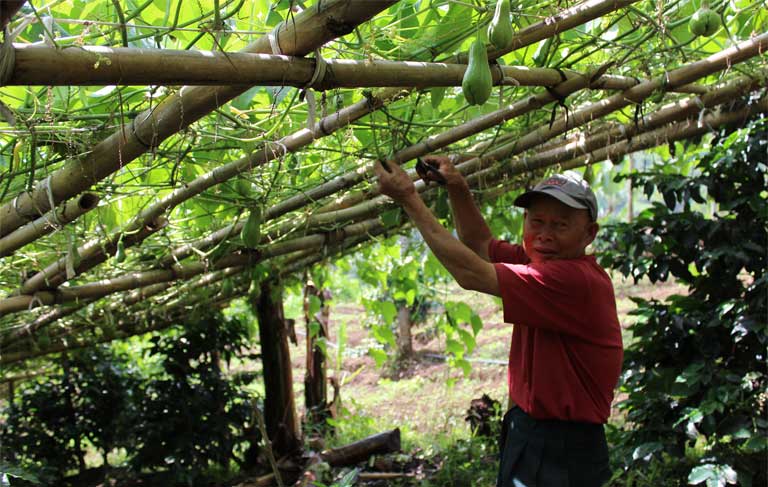
Despite all the research and effort by rescue centers, many confiscated lorises can never be released back to the wild: with their teeth removed and their health permanently damaged by captivity, they can no longer survive on their own.
“For lorises in trade, even if they are seized, few have a bright future,” says Shepherd. “The key is to put an end to the trade. Merely seizing animals does little or nothing to end the trade — poachers, traders and buyers must be prosecuted if we are to see a decline in this illegal trade.”
International efforts to save the loris
The global trade in lorises means that purely local programs won’t suffice to conserve these animals — coordinated international and national planning is needed.
As part of that effort, the Little Fireface Project has been compiling national action plans for loris range countries and sharing that data. They also educate wildlife officers to be able to rapidly identify a slow loris when seen, so it can be confiscated and quickly moved to a rescue center.
A joint effort between Nekaris’ project and TRAFFIC, the international wildlife trade monitoring NGO, resulted in a recent trip by her to Japan. There it’s legal to own a pet loris with the proper permit, but poor enforcement has resulted in many illegally smuggled animals entering the market.

Nekaris, for example, saw one loris for sale, mislabeled as the wrong species but with a CITES permit for that erroneous species. She spotted another animal, clearly a baby, with an accompanying wildlife permit that was several years old. Still, she has hope: “The government [of Japan] wants to change the laws so this can’t happen anymore, and that’s a huge step forward.”
Much of the project’s most important international work is done on the internet, where it disseminates information to educate people about the animal cruelty inherent in the pet trade, the making of loris videos, and the keeping of these primates as pets. That work — like the educating of farmers — is making a difference.
As people come to know and love these animals, and the suffering to which they are being subjected, they change their views, says Nekaris. The project tracked and counted online comments over a period of three years and witnessed a transformation: “We saw the number of people fighting for the loris increase statistically and dramatically,” she says. That message is “getting more powerful, the voice of people saying it’s cruel or illegal [to own a loris and that] they should not be kept as a pet.”
On her travels over time, she’s noticed that it’s becoming harder to find lorises in wildlife markets. “We used to see thirty or forty. Now you might see one,” she says of markets she’s visited. “This eliminates impulse buyers. Now you probably still can get one, but you have to go through the illegal supply chain — you can’t just buy openly on the street.”
She saw similar changes happening on her visit to Japan: “The seller would say, ‘if you want this animal you’d better buy it today, because we don’t know when we’ll see another,’ when just a couple years ago you could buy them anywhere. For me that’s a huge change.”
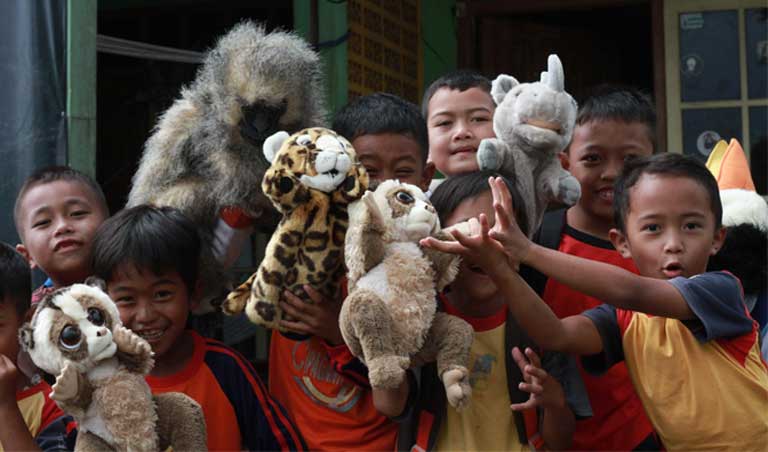
More to be done
These signs of progress are encouraging, says Nekaris, and the Little Fireface Project has done an amazing amount with a team of less than a dozen people. But much remains to be accomplished to ensure slow loris survival.
The animals continue to be hunted for use in traditional medicine, and there is no project working on that problem. “There needs to be something on the ground, with a behavioral change model, working with local traditional medicinal practitioners,” she says.
Nekaris’ research in Cambodia found that the animals are used to create childbirth tonics and to treat stomach problems, wounds and broken bones, as well as sexually transmitted diseases. Interestingly, the main consumers of these loris-derived “cures” were found to be upper and middle class women. Shepherd says that this trade occurs throughout the region; TRAFFIC, for example, has documented both the medicinal trade and hunting for meat in Myanmar.
As with so many Almost Famous Asian animal species, the most basic problem remains the lack of money going to slow loris conservation. No big international conservation organizations are sending out colorful yearend mailers beseeching donors “to save the loris!”
In fact, Nekaris originally decided to focus on these small primates because of her frustration regarding their upstaging by large, attention-getting charismatic animals like orangutans and tigers: “I kept telling people the lorises were being annihilated, and the answer I got was, ‘we are working on the important species.'”
The rescue centers experience the same problem. “I’ve been told that lorises aren’t good fundraisers, [and the rescue centers] often have to use money from other species to pay for their loris programs,” Nekaris says. “You think they’re so cute, but they can never beat an orangutan.”
No one has so far found an alternative fundraising approach to the charismatic megafauna appeals conducted by big conservation organizations. Which means that many ecosystems and threatened keystone animal species — not to mention endangered plants — aren’t getting the vital help they need to stay viable in the wild.
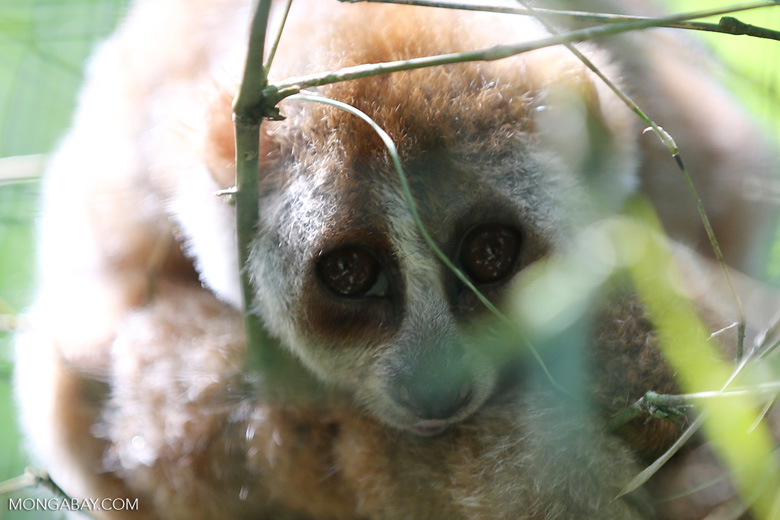
Unfortunately for lorises, it can cost as much to save them as orangutans. Conservation work isn’t cheap: properly reintroducing one loris, including pre-release medical care, husbandry, a radio collar, plus a year of tracking, runs something like US $20,000 dollars.
“Everyone wants to know how many [lorises] are left [in the wild] and we really don’t know,” Nekaris laments, but she adds that a $200,000 grant could begin to answer that question. When asked if that kind of money is being donated to loris research now, she bursts out in a surprised laugh: “No way!” Since the start of the Little Fireface Project in 1993, the team has only once received a grant that substantial, and it was for a study of the venom that so fascinates humans.
How to help the slow loris
Nekaris emphasizes that you don’t need to donate $200,000 to help the slow loris. Just resisting a single computer keystroke can help: Don’t “like” and share online loris videos, and instead, post educational comments on those posts, says Nekaris.
“Put up a conservation message on the video,” she recommends. “Do your best not to be antagonistic. The uploader may not know any better. Sometimes the uploader may be the person who owns the animal, but sometimes they may have just shared it and they have no idea [of the cruelty being inflicted].”
When you travel, Nekaris suggests, don’t have your photo taken with lorises and other captive wild animals. These photo prop lorises often suffer in even worse conditions than pets. “They’re taken from the wild, often they’re drugged, their teeth are ripped out, they’re working twelve to twenty hours a day. The same animal is passed from [vendor to vendor] and never gets to sleep; they’re working out in the daylight,” and they’re nocturnal, she says. “The [animal] welfare is horrific.”

Kenyon adds that tourist tipoffs have in the past led her team to rescue lorises from these photo prop situations, and she suggests that travelers spotting such activity report it to local authorities.
It’s also important to make forest-friendly consumer choices: in particular, buy only products made with certified sustainable palm oil, recommends Nekaris. Oil palm production is a huge forest conservation issue in Southeast Asia — and its rapid, poorly regulated growth is not only impacting orangutans. It is affecting lorises and other animals as well.
Caring about the slow loris helps other wildlife, Nekaris concludes: “I now see the loris as a poster child for all of the unusual reptiles, small mammals, and birds that are constantly being overlooked in favor of these large charismatic species that people have more empathy with,” she says. “Only very recently have people started to feel that [same] empathy for slow lorises, and that’s been a huge transition in my research.”

